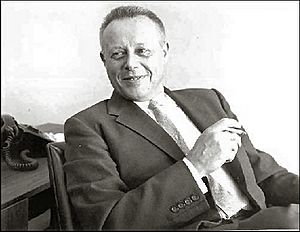Karel Bossart facts for kids
Quick facts for kids
Karel Bossart
|
|
|---|---|
 |
|
| Born |
Karel Jan Bossart
February 9, 1904 |
| Died | August 3, 1975 (aged 71) San Diego, U.S.
|
| Citizenship | Belgian–American |
| Alma mater | Université libre de Bruxelles |
| Occupation | Rocket engineer |
| Known for | Atlas ICBM |
| Spouse(s) | Cornelia Chase |
| Children | 3 |
| Awards | Exceptional Civilian Award |
Karel Jan Bossart (born February 9, 1904 – died August 3, 1975) was a brilliant rocket engineer. He is best known for creating the Atlas rocket, a very important missile and launch vehicle. His work was as important as that of other famous rocket scientists like Wernher von Braun and Sergei Korolev. Because much of his work was secret for the United States Air Force, many people don't know about his amazing achievements.
Contents
Early Life and Education
Karel Bossart was born in Antwerp, Belgium, on February 9, 1904. He studied Mining Engineering at the Université libre de Bruxelles and graduated in 1924.
After college, he won a special scholarship. This allowed him to study aeronautical engineering, which is about designing aircraft, at the Massachusetts Institute of Technology in the United States. He decided to stay in the U.S. and worked for different airplane companies.
Developing the Atlas Rocket
A Big Idea for Missiles
In 1945, Bossart was a chief engineer at a company called Convair. He suggested a bold idea to the United States Air Force: building a missile that could travel 8,000 kilometers (about 5,000 miles)!
At first, the Air Force was not sure about his idea. They wanted to focus on large bomber planes. But they gave Bossart a small contract to start working on a test missile.
Bossart's Smart Design
Bossart came up with a very clever design for his missile. He used a "monocoque" structure. This means the outer skin of the missile helped hold it together, like an eggshell. The fuel tanks inside were kept under pressure, which also helped the missile stay strong. This was a new and smart way to build rockets.
The Atlas Project Begins
After some tests in 1947, the Air Force lost interest in the missile project for a while. But by 1951, the Cold War was heating up. This was a time of tension between the United States and the Soviet Union. The Air Force realized they needed powerful missiles.
This allowed Bossart to restart his project, which became known as the 'Atlas' missile. In 1955, the U.S. learned that the Soviet Union was making fast progress on its own long-range missiles. So, the Atlas project became super important for national safety.
Bossart also used this chance to work on rockets that used special, very cold fuels. This led to the creation of the Centaur upper stage, which is a part of a rocket that helps it go even higher and faster.
First Flight and Recognition
The Atlas rocket was first launched in June 1957. It was not always perfect as a missile, but it became an amazing launch vehicle. A launch vehicle is a rocket used to send things into space. The Atlas design has been used for many successful and reliable rockets.
On December 17, 1957, after eleven years of hard work, Bossart saw the first successful flight of the Atlas rocket. A few days later, he appeared on a TV show called What's My Line? as a "Rocket Designer." The next year, the Air Force gave him the Exceptional Civilian Award for his work.
Atlas Rocket Achievements
Thanks to Bossart's Atlas design, many important things were launched into space:
- The first communications satellite, which helps us talk across the world.
- The first U.S. missions with astronauts orbiting Earth.
- The Mariner probes that traveled to Mars and Venus.
- The Pioneer 10 and Pioneer 11 probes that explored Jupiter and Saturn.
Later Career and Legacy
In 1955, Bossart became the chief engineer for the Atlas project. In 1957, he was promoted to Technical Director of Aeronautics at General Dynamics, another big company.
His co-workers admired him greatly. They said he was one of the best technical minds in the country and that he led a major step forward in rocket science.
In 1965, Karel Bossart was honored by being added to the International Air & Space Hall of Fame. You can see an exhibit about him at the San Diego Air & Space Museum. He was also inducted into the International Space Hall of Fame in 1990.
Karel Bossart passed away on August 3, 1975, in San Diego, California. His work helped shape space exploration as we know it today.

